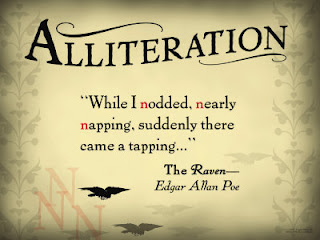Assonance & Alliteration
On yesterday’s show, Ron
asked about the difference between assonance and alliteration. Both terms apply
to poetic techniques.
Assonance is the deliberate repetition of similar vowel
sounds, usually with a specific effect in mind, such as soothing or alarming.
The appeal is to the ear, which is why most poetry should be read aloud, even
when alone. The word comes from the Latin ad-, toward, and sonare, to sound.
Tennyson’s
Lotos-eaters uses assonance to
duplicate the drowsiness that a drug user might feel:
The
Lotos blooms below the barren peak:
The
Lotos blows by every winding creek:
All
day the wind breathes low with mellower tone
Thro’
every hollow cave and alley lone,
Round
and round the spicy downs the yellow Lotos-dust is blown.
Alliteration is the deliberate repetition of similar
consonant sounds, especially at the beginning of words. (Accidental
alliteration is also a consideration since there are more consonants than
vowels.) The word comes from the Latin ad-, toward, and littera,
letter.
Edgar Allan Poe’s The
Raven used alliteration. Notice
the predominant D’s here:
Deep
into that darkness peering, long I stood there wondering, fearing,
Doubting,
dreaming dreams no mortal ever dared to dream before
And in this section of
Gerard Manley Hopkins’s The Windhover, notice the outbreak of M’s and D’s:
I
caught this morning morning's minion, king -
dom
of daylight's dauphin, dapple-dawn-drawn Falcon, in his riding
Of
the rolling level underneath him steady air . . .
Available from McFarland & Co.: Word Parts
Dictionary, 2nd edition
Now available as an ebook
Now available as an ebook
Listen to Mike’s program
in real time every Tuesday morning, 9:10 - 10:00 a.m. EST, by going to
wtcmradio.com and clicking on Listen Now. You’ll also find about a month’s worth of podcasts there under The
Ron Jolly Show.
Visit The Senior Corner,
a web site containing information for senior citizens.



Comments